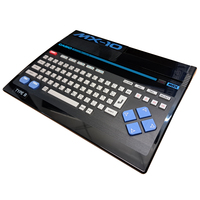Casio MSX Personal Computer MX-10 Type B
| Home > Browse Our Collection > Computers > Casio > Casio MSX Personal Computer MX-10 Type B |
|
The MX-10 is the successor of the Casio PV-16 with the same characteristics but with an exception: to make the computer as small as possible, the tape interface was removed from the machine as with the PV-7. As a result, the MX-10 requires the FA-32 CMT I/F package in order to use a cassette recorder. The "Type B" sticker on the left side just below the keyboard means it has two separate joystick trigger buttons. This machine was aimed at the Japanese market. Both the computer and the expansion unit were available in black (BK) and red (RD) colours. This machine was adapted for the international market as the MX-15. MSX is the name of a standardised home computer architecture, first announced by Microsoft on June 16, 1983, conceived by Kazuhiko Nishi, then Vice-president at Microsoft Japan and Director at ASCII Corporation. It is said that Microsoft led the project as an attempt to create unified standards among hardware makers MSX spawned four generations: MSX (1983); MSX2 (1986); MSX2+ (1988); and MSX TurboR (1990). The first three were 8-bit computers based on the Z80 microprocessor. MSX never became the worldwide standard that its makers had envisioned, mainly because it never took off in the U.S. and the UK. However, in Japan, South Korea, Argentina, and Brazil, MSX was the paramount home computer system of the 1980s. The exact meaning of the "MSX" abbreviation remains a matter of debate. At the time, most people seemed to agree it meant 'MicroSoft eXtended', referring to the built-in "Microsoft eXtended BASIC" (MSX-BASIC), specifically adapted by Microsoft for the MSX system. Manufacturer: Casio Comment on This Page Casio MSX Personal Computer MX-10 Type B Manuals:
Magazines RELATED to Casio MSX Personal Computer MX-10 Type B in our Library
Other Systems Related To Casio MSX Personal Computer MX-10 Type B:
This exhibit has a reference ID of CH33421. Please quote this reference ID in any communication with the Centre for Computing History. |
Click on the Image(s) For Detail
|












